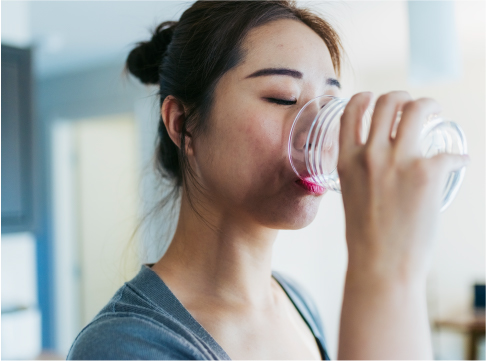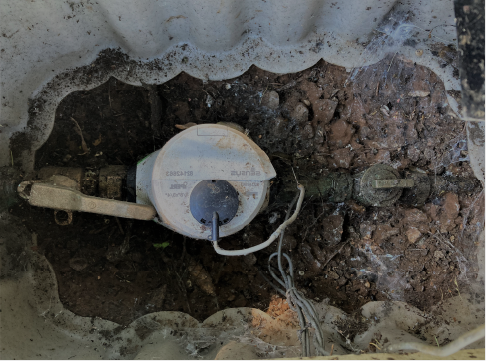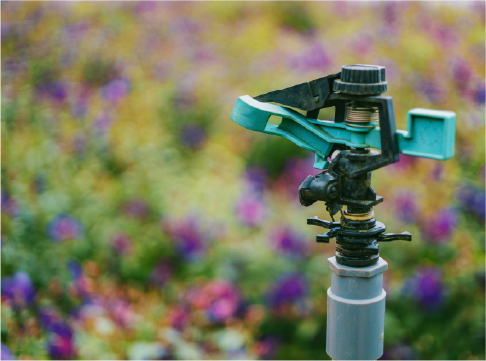Download the 2024 Consumer Confidence Report.
For water quality questions or to request a printed copy of this report, please call 541-685-7861 or send us an email.
This report is a summary of the quality of water that EWEB provided to customers in 2024. We are happy to report that your water meets and exceeds all state and federal drinking water health standards and that EWEB retains our “Outstanding Performer” status with the Oregon Health Authority (OHA).
Download a PDF copy of the report, scroll down to view the online version, or use the following menu to jump to a section.
Your water source | 2024 regulated contaminant results | Copper and lead sampling results | Information about drinking water contaminants | Notes on EWEB-detected contaminants | Boil-water advisories
Clean water starts at the source
 As an EWEB customer, you receive some of the highest quality drinking water in the world
As an EWEB customer, you receive some of the highest quality drinking water in the world
Your water comes from the pristine McKenzie River, which emerges from Clear Lake, high in the Cascade Mountains. Clear Lake is a spring-fed lake, the water bubbling to the surface through acres of natural volcanic “filters,” before flowing 85 miles down the McKenzie River to the Hayden Bridge Water Filtration Plant in Springfield, where the Eugene Water & Electric Board (EWEB) draws water from the river.
EWEB has completed a Source Water Assessment to identify potential contaminants of concern for our drinking water. Although the McKenzie River has faced some major challenges over the last few years, overall water quality remains excellent. EWEB works with residents throughout the watershed to minimize contaminants from pesticides and urban runoff, and coordinates with multiple emergency responders to prepare for potential hazardous material spills. With climate change bringing warmer and drier weather, our watershed will endure greater threats in the forms of droughts, wildfires, and harmful algal blooms.
Learn more about EWEB’s source water monitoring and protection program2024 regulated contaminant results
Your water met or exceeded all state and federal drinking water health standards
This report provides a snapshot of last year’s water quality. The following table summarizes the regulated contaminants that were detected in the water. EWEB is proud to say that we have never violated a maximum contaminant level or any other water quality standard established by the Environmental Protection Agency (EPA).
For information on EWEB’s drinking water monitoring program view our Water Quality webpage, call 541-685-7861, or email water.quality@eweb.org. For a list of definitions and abbreviations, click here.
|
Test |
MCL |
MCLG |
Detection Range |
Probable Source |
In Compliance? |
|---|---|---|---|---|---|
|
Inorganics |
|||||
|
Barium (ppm) |
2 |
2 |
ND - 0.002 |
Erosion of natural deposits |
Yes |
|
Fluoride (ppm) |
4 |
4 |
ND - 0.057 |
Erosion of natural deposits |
Yes |
|
Nitrate (ppm) |
10 |
10 |
ND - 0.15 |
Runoff from fertilizer use; Leaching from septic tanks, sewage; Erosion of natural deposits |
Yes |
|
Disinfection Byproducts |
|||||
|
Total Trihalomethanes (ppb) |
80 |
n/a |
8.0 - 22 |
Byproduct of drinking water disinfection |
Yes |
|
Haloacetic Acids (ppb) |
60 |
n/a |
4.5 - 8.2 |
Byproduct of drinking water disinfection |
Yes |
|
Chlorine (ppm) |
4 |
4 |
0.19 - 0.81 |
Added to control microbes |
Yes |
|
Total Organic Carbon (ppm) |
TT |
n/a |
0.26 - 0.73 |
Naturally present in the environment |
Yes |
|
Microbiological |
|||||
|
Turbidity (ntu) |
TT<0.3 |
n/a |
Highest result: 0.038 |
Soil run-off |
Yes |
Copper and lead sampling results
The State requires EWEB to collect samples from 50 high-risk residential water taps once every three years. The following table represents our most recent testing results from 2024. Click here to view definitions and abbreviations.
|
Contaminant |
Action Level (AL) |
MCLG |
90th Percentile Result |
Result Range |
Samples Exceeding AL |
Source of Contamination |
|
Copper (ppm) |
1.3 |
1.3 |
0.070 |
0.007-0.094 |
0 |
Corrosion of household plumbing systems |
|
Lead (ppb) |
15 |
0 |
4.5 |
ND-9.7 |
0 |
How lead could get into your household drinking water
If present, elevated levels of lead can cause serious health problems, especially for pregnant women and young children. Lead in drinking water is primarily from materials and components associated with service lines and home plumbing.
EWEB is responsible for providing high quality drinking water to your meter, but cannot control the variety of materials used in plumbing components once water leaves EWEB-owned service lines. In Eugene, the most common sources of lead in drinking water are brass or chrome-plated brass faucets and other piping that utilized lead solder in customer-owned plumbing.
^ Return to menu
What the EPA says about drinking water contaminants
Drinking water, including bottled water, may reasonably be expected to contain at least small amounts of some contaminants. The presence of contaminants does not necessarily indicate water poses a health risk. More information about contaminants and potential health effects can be obtained by calling the EPA’s Safe Drinking Water Hotline at 1-800-426-4791 or visiting: www.epa.gov/ground-water-and-drinking-water/safe-drinking-water-information.
The sources of drinking water (both tap and bottled water) include rivers, lakes, streams, ponds, reservoirs, springs and wells. As water travels over the surface of the land or through the ground, it dissolves naturally-occurring minerals and, in some cases, radioactive material, and can pick up substances resulting from the presence of animals or from human activity.
In order to ensure that tap water is safe to drink, EPA prescribes regulations that limit the amount of certain contaminants in water provided by public water systems. Food and Drug Administration regulations establish limits for contaminants in bottled water which must provide the same protection for public health.
|
Contaminants in drinking water sources may include: |
||||
|
Microbial contaminants such as viruses and bacteria, which may come from wildlife or septic systems. |
Inorganic contaminants such as salts and metals, which can occur naturally or result from urban storm water runoff, industrial or domestic wastewater discharges and farming. |
Pesticides and herbicides which may come from a variety of sources such as farming and forestry activities, urban storm water runoff, and home or business landscaping activities. |
Organic chemical contaminants including synthetic and volatile organic chemicals, which are byproducts of industrial processes. These substances also can come from gas stations, urban storm water runoff and septic systems. |
Radioactive contaminants can occur naturally or may result from oil and gas production and mining activities. |
 Special health considerations
Special health considerations
Some people may be more vulnerable to contaminants in drinking water than the general population. Immuno-compromised persons such as those with cancer undergoing chemotherapy, persons who have undergone organ transplants, people with HIV/AIDS or other immune system disorders, some elderly, and infants can be particularly at risk from infections. These people should seek advice about drinking water from their health care providers. EPA/CDC guidelines on appropriate means to lessen the risk of infection by Cryptosporidium and other microbial contaminants are available from the Safe Drinking Water Hotline (1-800-426-4791).
^ Return to menu
Notes on EWEB-detected contaminants
The following provides additional information about the contaminants that were detected in EWEB water:
|
Chlorine: EWEB adds chlorine to our water during the disinfection process to protect against microorganisms such as Giardia and E. coli. |
Copper: Copper is found in natural deposits and is also widely used in household plumbing materials. |
Turbidity: Turbidity is a measure of the cloudiness of water. It can interfere with disinfection. EWEB’s filtration process effectively removes turbidity. |
|
Barium/Fluoride: These naturally-occurring substances, found in the mineral composition of our watershed, were detected at extremely low levels — well below regulatory standards. |
Disinfection Byproducts (DBPs): Disinfectants are an essential element in drinking water treatment because of the barrier they provide against waterborne disease-causing microorganisms. DBPs form when disinfectants used to treat drinking water react with naturally-occurring materials in the water (e.g., decomposing plant and other organic material). |
Nitrate: Nitrate is an essential component of living things and occurs naturally in surface and groundwater at concentrations up to 1-2 mg/L. At these naturally-occurring levels, nitrate is not harmful to health. |
|
Total Organic Carbon: A measure of naturally-occurring organic materials in water. |
Boil-water advisories
A “boil-water advisory” is a precautionary notice issued when a community’s drinking water is or could be contaminated by disease-causing organisms. It is a preventive measure that is intended to protect the health of water consumers when there is an actual or significant possibility that contamination may be present within the drinking water system. In 2024, EWEB issued 12 boil-water advisories due to loss of water pressure in distribution pipes.
|
Date |
Location |
Customers Affected |
|
1/17/2024 |
Capital Dr |
6 |
|
5/23/2024 |
Patterson St & Hilyard St |
11 |
|
7/12/2024 |
Barger Dr & W Port St |
29 |
|
7/16/2024 |
Lawrence St |
4 |
|
7/20/2024 |
Cross St |
1 |
|
7/21/2024 |
Dove St |
16 |
|
7/21/2024 |
Van Ave |
8 |
|
10/16/2024 |
Madison St and W 28th Ave |
4 |
|
10/25/2024 |
Wilson Dr |
2 |
|
11/4/2024 |
City View 1150 |
35 |
|
12/26/2024 |
S Louis Ln |
3 |
|
12/29/2024 |
S Louis Ln |
3 |
For all advisories, the system was repaired and water pressure restored within a few hours. EWEB then tested water samples for the presence of bacteria. Results from these tests were available after 18 hours, and in all cases EWEB was able to notify the affected customers that the water was safe for consumption. The health of the community is our top priority and EWEB will continue to follow best practices to reduce the risk of contamination entering the water system.
^ Return to menu
Access to clean water is vital to our community. That is why we work hard to deliver water that meets or exceeds all state and federal health standards.
In case of a disaster of any type, it may be necessary to turn off utilities to avoid damage to your home.





